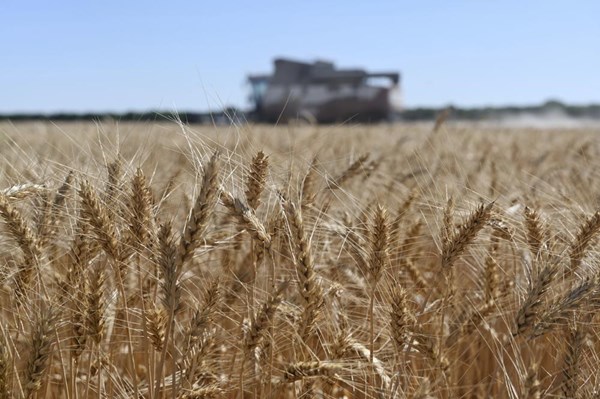
The Russian Deputy Prime Minister confirms that most of the deals are with Iran, Syria, Egypt, and the CIS [Commonwealth of Independent States] countries.
-

A harvester collecting wheat in Semikarakorsky District of Rostov-on-Don region near Semikarakorsk, Russia, on July 6, 2022 (AP)
In an interview with RIA Novosti, Russian Deputy Prime Minister Viktoria Abramchenko confirmed that Russia has entered more than 750 contracts on grain, sugar, and oil exports in national currencies this year.
“This year alone, more than 750 contracts for grain, oil, and sugar have been concluded in national currencies, which is 1.5 million tonnes of products. Most of the deals are with Iran, Syria, Egypt and the CIS [Commonwealth of Independent States] countries,” she said on the sidelines of the St. Petersburg International Economic Forum (SPIEF), which is taking place between June 14 and 17.
According to Abramchenko, grain deliveries with settlements in national currencies were prioritized as the number of contracts is expected to increase.
“If we talk about grain, in the first four months of this year, already more than 5% of exports are in national currencies,” she stated, adding that Russia is “engaged in negotiations with all friendly countries. In total, our agricultural exports include 160 countries worldwide. And, of course, we are interested in trading in rubles. But the readiness of a receiving country is also important”.
Read more: Ukraine sending grain to EU, not developing nations: Putin
Back in January, Abramchenko relayed to RIA Novosti that Turkey paid for grain deliveries in rubles while adding that a similar supply deal was being worked with Egypt.
The SPIEF was established in 1997 and has been headed by the President of the Russian Federation since 2006.
The draconian sanctions by the West upon Russia ever since the start of the war in Ukraine last year seem to have backfired, strengthening Russian ties with other nations like Iran, India, China, and Brazil.
In a report released by the Bank of Russia in March, shares of “toxic” currencies of settlements for Russian exports dropped to 48% from a whopping 87% in 2022, and for imports from 65% to 46%. The report also found that the alternative currency of settlements besides the Russian ruble was the Chinese yuan.
The term ‘toxic currency’ is a term used by central banks to refer to the US dollar and the European euro.
The Ministry of Economic Development predicts an average annual exchange rate of 68.1 rubles per USD in 2022, 68.3 rubles per USD in 2023, 70.9 rubles in 2024, and 72.2 rubles in 2025.
Read next: Moscow: West is burying Russian part of grain deal




